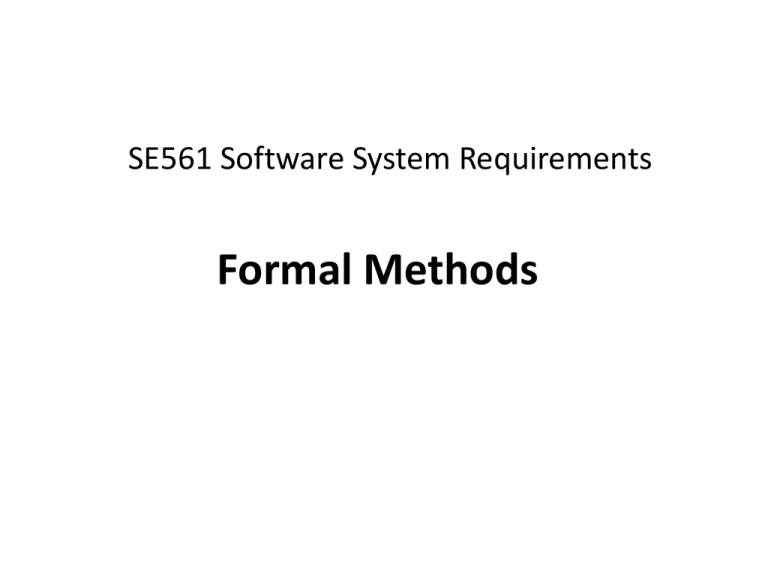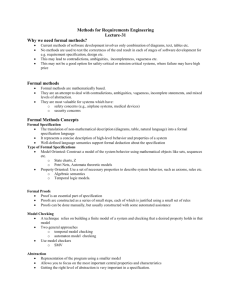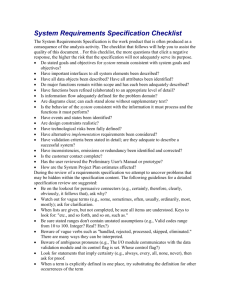Formal method in software engineering
advertisement

SE561 Software System Requirements Formal Methods Software Engineering and Formal Methods Every software engineering methodology is based on a recommended development process proceeding through several phases: Requirements, Specification, Design Coding, Unit Testing Integration and System Testing, Maintenance Formal methods can Be a foundation for designing safety critical systems Be a foundation for describing complex systems Provide support for program development What are Formal Methods? Techniques and tools based on mathematics and formal logic Can assume various forms and levels of rigor Informal Low Medium High Why Consider Formal Methods? The development of a formal specification provides insights and an understanding of the software requirements and software design Clarify customers’ requirements Reveal and remove ambiguity, inconsistency and incompleteness Facilitate communication of requirement or design Provides a basis for an elegant software design Traceability System-level requirements should be traceable to subsystems or components Formal Methods Concepts Formal Specification Methods Formal Formal specification Proofs Model checking Abstraction Formal Specification The translation of non-mathematical description (diagrams, table, natural language) into a formal specification language It represents a concise description of high-level behavior and properties of a system Well-defined language semantics support formal deduction about the specification Type of Formal Specifications Model Oriented: Construct a model of the system behavior using mathematical objects like sets, sequences etc. Statecharts, SCR, VDM, Z Petri Nets, CCS, CSP, Automata theoretic models Property Oriented: Use a set of necessary properties to describe system behavior, such as axioms, rules etc. Algebraic semantics Temporal logic models. Formal Proofs Proof is an essential part of specification Proofs are constructed as a series of small steps, each of which is justified using a small set of rules Proofs can be done manually, but usually constructed with some automated assistance Model Checking A technique relies on building a finite model of a system and checking that a desired property holds in that model Two general approaches temporal model checking automaton model checking Use model checkers SMV Abstraction Representation of the program using a smaller model Allows you to focus on the most important central properties and characteristics Getting the right level of abstraction is very important in a specification. Mathematical Models Abstract representations of a system using mathematical entities and concepts Model should captures the essential characteristics of the system while ignoring irrelevant details Model can be analyzed using mathematical reasoning to prove system properties or derive new behaviors. Two types Continuous models Discrete models Formal Specification Process Model Clarify requirements and high level design Articulate implicit assumptions Identify undocumented or unexpected assumptions Expose defects Identify exceptions Evaluate test coverage Cleanroom software development Spend a lot of effort "up-front" to prevent defects Formal specification Incremental development Statistical methods to ensure reliability Cleanroom Process Formal specification using a state transition model Structured programming - limited control and abstraction constructs are used Program resembles state machine Static verification using rigorous inspections Mathematical arguments Statistical testing of the system reliability Cleanroom Process Formally specify system Error rework Define software increments Develop operational profile Construct structured program Formally verify code Design statistical tests Integrate increment Test integrated system Cleanroom Process Incremental development Allows freezing of requirements, so formal work can proceed Work on critical functionality in early revisions, so it receives the most testing Cleanroom Process Specification team. Develop and maintain system specification Development team. Develop and verify (mathematically) the software. The software is not executed or even compiled during this process Certification team. Develop set of statistical tests to exercise the software after development. Reliability growth models used to determine when reliability is acceptable Test Results Successful in the field Few errors Not more expensive than other processes Generally workable Higher quality code resulted Benefits of Formal Specifications Higher level of rigor leads to better problem understanding Defects are uncovered that would be missed using traditional specification methods Allows earlier defect identification Formal specification language semantics allow checks for selfconsistency Enables the use of formal proofs to establish fundamental system properties and invariants Limitations to Formal Methods Requires a sound mathematical knowledge of the developer Different aspects of a design may be represented by different formal specification methods Useful for consistency checks, but formal methods cannot guarantee the completeness of a specifications For the majority of systems Does not offer significant cost or quality advantages over others Review What We learned … Fundamental requirements engineering concepts Requirements engineering processes Requirements engineering techniques Requirements Engineering Concepts Requirements – define what a system is required to do and the constraints under which it is required to operate Requirements engineering – all activities involved in discovering, documenting, and maintaining a set of requirements for a computerbased system The term engineering implies that systematic and repeatable techniques (based on Best Practices) should be used The first step in system development Include Functional requirements Non-functional requirements Stakeholders Software engineers, system end-users, managers of system end-users, external regulators, domain experts Requirements Engineering Processes Existing systems information Agreed requirements Stakeholder needs Organisational standards Regulations Domain information Requirements engineering process System specification System models Requirements Engineering Processes Requirements elicitation Requirements analysis and negotiation Requirements documentation User needs domain information, existing system information, regulations, standards, etc. Requirements validation Requirements document System specification Agreed requirements IBM Rational RequisitPro for requirements documentation and management SRS template for final specification Requirements Engineering Techniques Process of requirements engineering (RE) is usually guided by a requirements method Requirement methods are systematic ways of producing system models System models are important bridges between the analysis and the design process Types Structured analysis Object-oriented analysis Requirements Engineering Techniques Data flow modeling One of the most popular structured methods DFD provides a description of a system based on modeling the transformational processes of a system, the collections (stores) of data that the system manipulates, and the flows of data between the processes, stores and the outside world. The DFD describes the functional viewpoint of the system e.g. it describes the system in terms of its operation (tasks). Conducted hierarchically. Requirements Engineering Techniques Object-oriented approach integrate data and functions Use case diagrams Activity diagrams Class diagrams Sequence diagrams Collaboration diagrams State diagrams Requirements Engineering Techniques Non-functional requirements Define the overall qualities or attributes of the resulting system Examples of NFR include safety, security, usability, reliability and performance requirements. Classification Product requirements Process requirements External requirements Derive NFRs Concern decomposition Goal-based Formal methods in requirements engineering Final Exam Dec. 18, 1:00 – 3:00, BH 223 Open book, open notes, no laptop One problem on drawing DFD, context level and level 1 One problem on drawing class diagram and sequence diagrams One problem on non-functional requirements One problem on formal methods





![Purchase Request Form [L02]](http://s3.studylib.net/store/data/008565490_1-0019a09aa88e76e75b2b5be9eeb9fadb-300x300.png)


